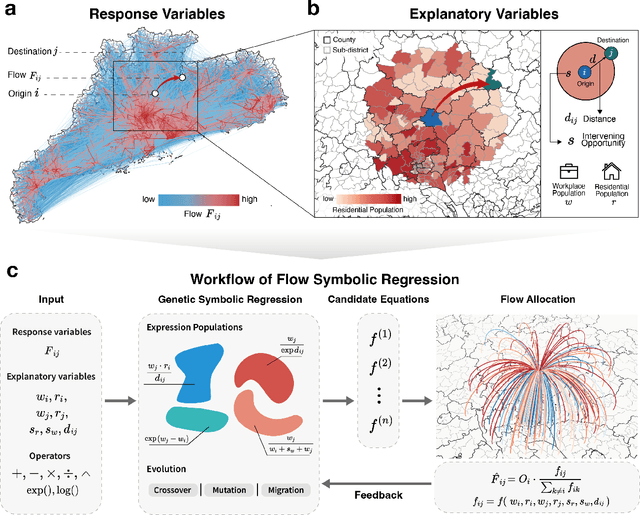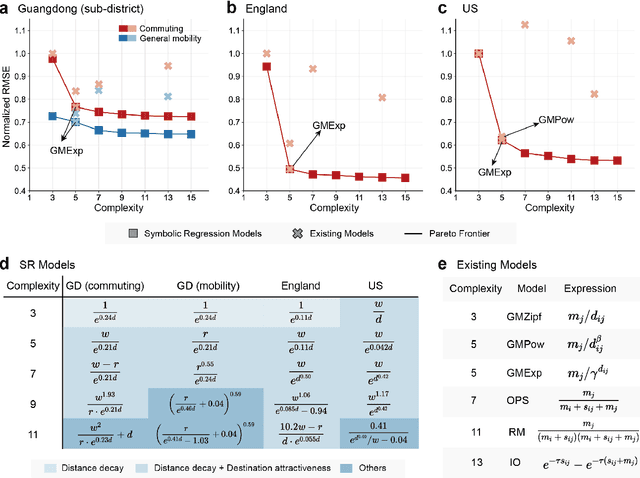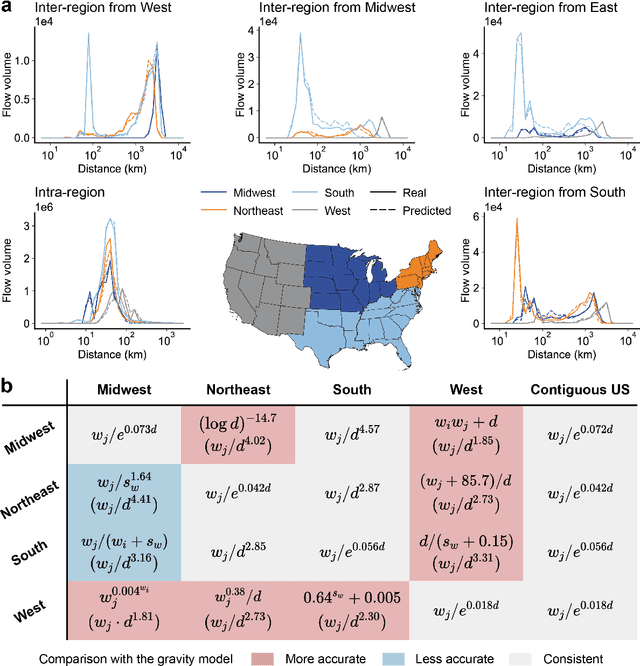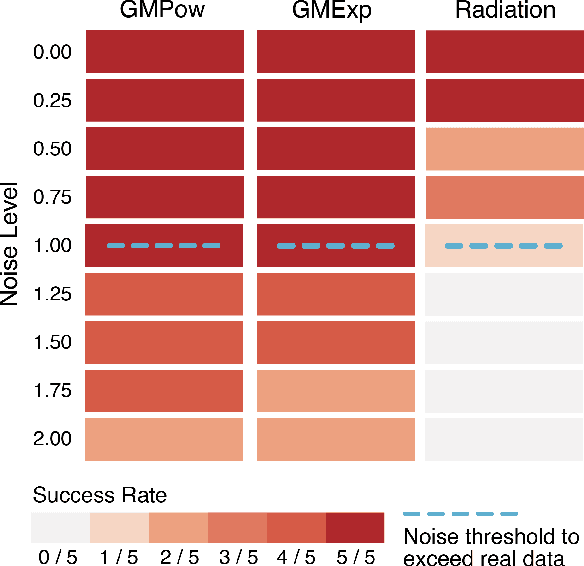Hao Guo
Chalmers University of Technology
Action is All You Need: Dual-Flow Generative Ranking Network for Recommendation
May 22, 2025Abstract:We introduce the Dual-Flow Generative Ranking Network (DFGR), a two-stream architecture designed for recommendation systems. DFGR integrates innovative interaction patterns between real and fake flows within the QKV modules of the self-attention mechanism, enhancing both training and inference efficiency. This approach effectively addresses a key limitation observed in Meta's proposed HSTU generative recommendation approach, where heterogeneous information volumes are mapped into identical vector spaces, leading to training instability. Unlike traditional recommendation models, DFGR only relies on user history behavior sequences and minimal attribute information, eliminating the need for extensive manual feature engineering. Comprehensive evaluations on open-source and industrial datasets reveal DFGR's superior performance compared to established baselines such as DIN, DCN, DIEN, and DeepFM. We also investigate optimal parameter allocation strategies under computational constraints, establishing DFGR as an efficient and effective next-generation generate ranking paradigm.
Cross-layer Integrated Sensing and Communication: A Joint Industrial and Academic Perspective
May 16, 2025Abstract:Integrated sensing and communication (ISAC) enables radio systems to simultaneously sense and communicate with their environment. This paper, developed within the Hexa-X-II project funded by the European Union, presents a comprehensive cross-layer vision for ISAC in 6G networks, integrating insights from physical-layer design, hardware architectures, AI-driven intelligence, and protocol-level innovations. We begin by revisiting the foundational principles of ISAC, highlighting synergies and trade-offs between sensing and communication across different integration levels. Enabling technologies, such as multiband operation, massive and distributed MIMO, non-terrestrial networks, reconfigurable intelligent surfaces, and machine learning, are analyzed in conjunction with hardware considerations including waveform design, synchronization, and full-duplex operation. To bridge implementation and system-level evaluation, we introduce a quantitative cross-layer framework linking design parameters to key performance and value indicators. By synthesizing perspectives from both academia and industry, this paper outlines how deeply integrated ISAC can transform 6G into a programmable and context-aware platform supporting applications from reliable wireless access to autonomous mobility and digital twinning.
EventDiff: A Unified and Efficient Diffusion Model Framework for Event-based Video Frame Interpolation
May 13, 2025Abstract:Video Frame Interpolation (VFI) is a fundamental yet challenging task in computer vision, particularly under conditions involving large motion, occlusion, and lighting variation. Recent advancements in event cameras have opened up new opportunities for addressing these challenges. While existing event-based VFI methods have succeeded in recovering large and complex motions by leveraging handcrafted intermediate representations such as optical flow, these designs often compromise high-fidelity image reconstruction under subtle motion scenarios due to their reliance on explicit motion modeling. Meanwhile, diffusion models provide a promising alternative for VFI by reconstructing frames through a denoising process, eliminating the need for explicit motion estimation or warping operations. In this work, we propose EventDiff, a unified and efficient event-based diffusion model framework for VFI. EventDiff features a novel Event-Frame Hybrid AutoEncoder (HAE) equipped with a lightweight Spatial-Temporal Cross Attention (STCA) module that effectively fuses dynamic event streams with static frames. Unlike previous event-based VFI methods, EventDiff performs interpolation directly in the latent space via a denoising diffusion process, making it more robust across diverse and challenging VFI scenarios. Through a two-stage training strategy that first pretrains the HAE and then jointly optimizes it with the diffusion model, our method achieves state-of-the-art performance across multiple synthetic and real-world event VFI datasets. The proposed method outperforms existing state-of-the-art event-based VFI methods by up to 1.98dB in PSNR on Vimeo90K-Triplet and shows superior performance in SNU-FILM tasks with multiple difficulty levels. Compared to the emerging diffusion-based VFI approach, our method achieves up to 5.72dB PSNR gain on Vimeo90K-Triplet and 4.24X faster inference.
BRepFormer: Transformer-Based B-rep Geometric Feature Recognition
Apr 10, 2025



Abstract:Recognizing geometric features on B-rep models is a cornerstone technique for multimedia content-based retrieval and has been widely applied in intelligent manufacturing. However, previous research often merely focused on Machining Feature Recognition (MFR), falling short in effectively capturing the intricate topological and geometric characteristics of complex geometry features. In this paper, we propose BRepFormer, a novel transformer-based model to recognize both machining feature and complex CAD models' features. BRepFormer encodes and fuses the geometric and topological features of the models. Afterwards, BRepFormer utilizes a transformer architecture for feature propagation and a recognition head to identify geometry features. During each iteration of the transformer, we incorporate a bias that combines edge features and topology features to reinforce geometric constraints on each face. In addition, we also proposed a dataset named Complex B-rep Feature Dataset (CBF), comprising 20,000 B-rep models. By covering more complex B-rep models, it is better aligned with industrial applications. The experimental results demonstrate that BRepFormer achieves state-of-the-art accuracy on the MFInstSeg, MFTRCAD, and our CBF datasets.
Beyond Object Categories: Multi-Attribute Reference Understanding for Visual Grounding
Mar 25, 2025



Abstract:Referring expression comprehension (REC) aims at achieving object localization based on natural language descriptions. However, existing REC approaches are constrained by object category descriptions and single-attribute intention descriptions, hindering their application in real-world scenarios. In natural human-robot interactions, users often express their desires through individual states and intentions, accompanied by guiding gestures, rather than detailed object descriptions. To address this challenge, we propose Multi-ref EC, a novel task framework that integrates state descriptions, derived intentions, and embodied gestures to locate target objects. We introduce the State-Intention-Gesture Attributes Reference (SIGAR) dataset, which combines state and intention expressions with embodied references. Through extensive experiments with various baseline models on SIGAR, we demonstrate that properly ordered multi-attribute references contribute to improved localization performance, revealing that single-attribute reference is insufficient for natural human-robot interaction scenarios. Our findings underscore the importance of multi-attribute reference expressions in advancing visual-language understanding.
TUMTraffic-VideoQA: A Benchmark for Unified Spatio-Temporal Video Understanding in Traffic Scenes
Feb 04, 2025



Abstract:We present TUMTraffic-VideoQA, a novel dataset and benchmark designed for spatio-temporal video understanding in complex roadside traffic scenarios. The dataset comprises 1,000 videos, featuring 85,000 multiple-choice QA pairs, 2,300 object captioning, and 5,700 object grounding annotations, encompassing diverse real-world conditions such as adverse weather and traffic anomalies. By incorporating tuple-based spatio-temporal object expressions, TUMTraffic-VideoQA unifies three essential tasks-multiple-choice video question answering, referred object captioning, and spatio-temporal object grounding-within a cohesive evaluation framework. We further introduce the TUMTraffic-Qwen baseline model, enhanced with visual token sampling strategies, providing valuable insights into the challenges of fine-grained spatio-temporal reasoning. Extensive experiments demonstrate the dataset's complexity, highlight the limitations of existing models, and position TUMTraffic-VideoQA as a robust foundation for advancing research in intelligent transportation systems. The dataset and benchmark are publicly available to facilitate further exploration.
RegionGCN: Spatial-Heterogeneity-Aware Graph Convolutional Networks
Jan 29, 2025



Abstract:Modeling spatial heterogeneity in the data generation process is essential for understanding and predicting geographical phenomena. Despite their prevalence in geospatial tasks, neural network models usually assume spatial stationarity, which could limit their performance in the presence of spatial process heterogeneity. By allowing model parameters to vary over space, several approaches have been proposed to incorporate spatial heterogeneity into neural networks. However, current geographically weighting approaches are ineffective on graph neural networks, yielding no significant improvement in prediction accuracy. We assume the crux lies in the over-fitting risk brought by a large number of local parameters. Accordingly, we propose to model spatial process heterogeneity at the regional level rather than at the individual level, which largely reduces the number of spatially varying parameters. We further develop a heuristic optimization procedure to learn the region partition adaptively in the process of model training. Our proposed spatial-heterogeneity-aware graph convolutional network, named RegionGCN, is applied to the spatial prediction of county-level vote share in the 2016 US presidential election based on socioeconomic attributes. Results show that RegionGCN achieves significant improvement over the basic and geographically weighted GCNs. We also offer an exploratory analysis tool for the spatial variation of non-linear relationships through ensemble learning of regional partitions from RegionGCN. Our work contributes to the practice of Geospatial Artificial Intelligence (GeoAI) in tackling spatial heterogeneity.
Data driven discovery of human mobility models
Jan 10, 2025



Abstract:Human mobility is a fundamental aspect of social behavior, with broad applications in transportation, urban planning, and epidemic modeling. However, for decades new mathematical formulas to model mobility phenomena have been scarce and usually discovered by analogy to physical processes, such as the gravity model and the radiation model. These sporadic discoveries are often thought to rely on intuition and luck in fitting empirical data. Here, we propose a systematic approach that leverages symbolic regression to automatically discover interpretable models from human mobility data. Our approach finds several well-known formulas, such as the distance decay effect and classical gravity models, as well as previously unknown ones, such as an exponential-power-law decay that can be explained by the maximum entropy principle. By relaxing the constraints on the complexity of model expressions, we further show how key variables of human mobility are progressively incorporated into the model, making this framework a powerful tool for revealing the underlying mathematical structures of complex social phenomena directly from observational data.
Impact of Cognitive Load on Human Trust in Hybrid Human-Robot Collaboration
Dec 30, 2024Abstract:Human trust plays a crucial role in the effectiveness of human-robot collaboration. Despite its significance, the development and maintenance of an optimal trust level are obstructed by the complex nature of influencing factors and their mechanisms. This study investigates the effects of cognitive load on human trust within the context of a hybrid human-robot collaboration task. An experiment is conducted where the humans and the robot, acting as team members, collaboratively construct pyramids with differentiated levels of task complexity. Our findings reveal that cognitive load exerts diverse impacts on human trust in the robot. Notably, there is an increase in human trust under conditions of high cognitive load. Furthermore, the rewards for performance are substantially higher in tasks with high cognitive load compared to those with low cognitive load, and a significant correlation exists between human trust and the failure risk of performance in tasks with low and medium cognitive load. By integrating interdependent task steps, this research emphasizes the unique dynamics of hybrid human-robot collaboration scenarios. The insights gained not only contribute to understanding how cognitive load influences trust but also assist developers in optimizing collaborative target selection and designing more effective human-robot interfaces in such environments.
Each Fake News is Fake in its Own Way: An Attribution Multi-Granularity Benchmark for Multimodal Fake News Detection
Dec 19, 2024



Abstract:Social platforms, while facilitating access to information, have also become saturated with a plethora of fake news, resulting in negative consequences. Automatic multimodal fake news detection is a worthwhile pursuit. Existing multimodal fake news datasets only provide binary labels of real or fake. However, real news is alike, while each fake news is fake in its own way. These datasets fail to reflect the mixed nature of various types of multimodal fake news. To bridge the gap, we construct an attributing multi-granularity multimodal fake news detection dataset \amg, revealing the inherent fake pattern. Furthermore, we propose a multi-granularity clue alignment model \our to achieve multimodal fake news detection and attribution. Experimental results demonstrate that \amg is a challenging dataset, and its attribution setting opens up new avenues for future research.
 Add to Chrome
Add to Chrome Add to Firefox
Add to Firefox Add to Edge
Add to Edge